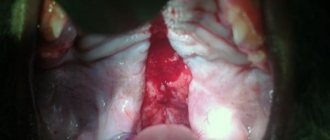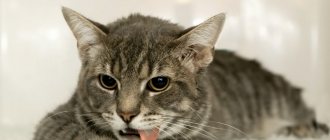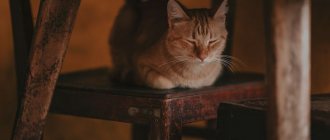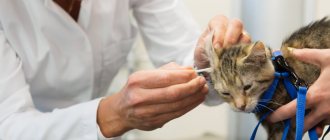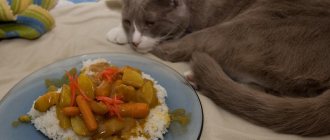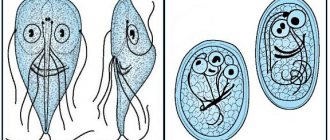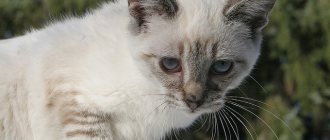If you observe diarrhea in a nursing cat, you need to immediately show it to a veterinarian in order to begin treating your beloved pet as quickly and effectively as possible. When choosing the optimal treatment regimen, you need to know the cause of this pathological condition. The doctor will need to collect an anamnesis, for which the owners will need to provide information on the cat’s diet and lifestyle over the past 4 days. It is important to remember that diarrhea can be a symptom of a serious illness, so leaving such problems with stool to chance is extremely dangerous.
Reasons for therapeutic failures
The first thing the owner tries to do is give a “fixing” tablet (an antidiarrheal drug), treat with hunger, and change the diet. With banal gluttony, this may help, but if the cause is internal, there is a suspicion of physiological or infectious factors, fighting diarrhea at home is pointless.
Reasons why the body does not respond to treatment:
- misdiagnosed;
- adequate diagnosis, but poor therapy;
- The prescriptions and diagnosis are correct, but the animal does not respond to treatment.
In all three cases, the result is zero, and the gastroenterologist has to change approaches to diagnosis, prescribing medications and working with the owner. Possible mistake: changing the drug, switching to stronger, newer and more expensive drugs.
Important! As practice shows, in 90% of cases where there is no effect from treatment and the animal does not feel better, this is an incorrect diagnosis. There is a habit here; the doctor does not delve into the problem, but identifies the most common cause of diarrhea.
Dogs and cats may have diseases of the pancreas, intestines, and liver. Decompensation often occurs, in which for the first reason the animal feels relatively well, but with the addition of another disease, the balance is completely disturbed. Therefore, you should not rely on a “magic pill” or an exceptional diet that will immediately improve the functioning of the digestive tract.
The first thing the owner must be prepared for is a thorough examination, the use of laboratory and instrumental methods, without this it is impossible to make a final and accurate diagnosis!
Diarrhea (diarrhea) in dogs and cats
Treatment of acute mild/self-limited diarrhea
Basically, in such cases, the doctor empirically prescribes symptomatic therapy.
The main goals he pursues are: restoration of water and electrolyte balance, diet correction, preventive treatment for worms and the prescription, if necessary, of antimicrobial drugs. Some doctors prescribe a fasting diet for 24-48 hours to give the intestines a rest to recover, but there is increasing evidence of the need for early feeding, which will stimulate the intestines, help restore weight and improve the outcome of treatment.
Diet
.
The animal needs to receive easily digestible food that is high in fiber and low in fat. Another option is an elimination diet, which contains a new source of protein
to eliminate food allergies (intolerance to any food component). It is better to divide the daily dose into 4-6 doses. The simplest option is commercial food from the brands Hill's, Eukanuba, Purina, Royal Canin (and other premium and super-premium quality). A more difficult option is home feeding with easily digestible and hypoallergenic food, for example, rice with chicken breast.
Enveloping, adsorbent, carminative and antacid agents (De-Nol, Almagel, Activated carbon, Espumisan, Maalox). They help absorb bacteria and toxins, reduce bloating, gas formation and fermentation, and also cover the gastrointestinal tract with a “protective film.” One of the most effective drugs is bismuth tripotassium dicitrate (trade name “De-Nol”), which has antitoxic, antibacterial, antisecretory and anti-inflammatory properties, another good and proven remedy is algeldrate with magnesium hydroxide (Almagel or Maalox), a less pronounced effect with activated carbon and simethicone (Espumizan). In general, despite the widespread use and large number of such drugs, they are prescribed as an additional remedy and do not radically affect the outcome of the disease.
Antimicrobial agents . It is advisable to use antibiotics if the diarrhea is caused by bacteria or protozoa, and also if the animal has severely damaged intestinal mucosa and there is a high risk of developing a secondary infection. In other situations, their use is questionable (they can disrupt the intestinal microflora and lead to the emergence of resistant bacteria).
Anthelmintic (anthelminthic) agents . They are prescribed if there is a high probability of the presence of helminths in the gastrointestinal tract or their presence is confirmed by tests. They use anthelmintic drugs for animals (veterinary drugs, not medical), such as Drontal, Prazicide, Kanikquantel and others. The number of treatments for worms varies - from one (preventive treatment once every 3-4 months) to several times (for example, at least 2 times with an interval of 2-4 weeks for toxocariasis).
Fluid therapy . An acute attack of diarrhea can lead to severe dehydration, and in such situations it is necessary to restore fluid balance. The most effective method is intravenous administration of solutions (dropper). The simplest of them are the so-called crystalloid solutions: physiological solution (0.9% NaCl solution), Ringer's solution, Ringer-Locke solution (in some cases they are combined with colloidal solutions or replaced with analogues).
Chronic diarrhea: what is it?
When describing diarrhea, breeders can only identify visible symptoms, such as foul-smelling and frequent bowel movements, poor health of the cat or dog, and external changes. But in fact, chronic diarrhea is a complex syndrome, observed over 2-3 weeks, which includes a lot of invisible aspects, sometimes difficult to diagnose.
At the first stage of the examination, it is important to understand whether acute or chronic diarrhea is present. This is important, since in acute conditions it is enough to conduct a series of standard laboratory tests, relieve the syndrome and prescribe supportive symptomatic therapy.
In chronic cases, everything is not so simple! The main thing is to find the “focus” due to which regular diarrhea occurs and prescribe etiotropic therapy.
At the second stage, you need to figure out whether the diarrhea is small intestinal or colonic, or of mixed origin.
Clinical observations in chronic diarrhea:
- no weight loss (colic diarrhea). As an exception, weight is lost, but then streaks of blood and mucus are present in the stool (severe course);
- changes in body condition or severe weight loss (small intestinal diarrhea).
Important! The impact of protozoa on the intestines should not be ruled out. In particular, Giardia, which “loves” the small intestine. And trichomonas, which cause symptoms of chronic diarrhea in cats, settle in the large intestine and do not respond to standard drugs against Giardia (Fenbendazole, Metronidazole, Albendazole).
Diagnostics
If a lactating cat has diarrhea repeatedly, then the breeder needs to show the pet to a veterinarian, who will conduct an initial examination, including:
- general assessment of condition;
- measuring body temperature;
- drying heart rate and respiratory activity;
- palpation of the abdominal cavity.
Additionally, the doctor may need blood and urine test results. If the purr's condition is severe, the veterinarian will also assess the degree of dehydration. Based on the results of the diagnostic examination, treatment is prescribed and a decision is made on further continuation of lactation.
Which parasites are the most dangerous?
Trichomonas is a parasite that causes chronic colonic diarrhea in cats (less commonly in dogs). Preference is given to animals of exotic breeds, since they have a less stable immune system due to frequent inbreeding (Bengal, Somali).
Giardia (red arrow) and Trichomonas (blue arrow)
Features of identifying Trichomonas:
- clinical signs indicating a problem with the large intestine;
- a detailed examination using direct methods, otherwise - a study of “freshly laid” feces (warm). With fresh stool, sensitivity is up to 15%, then it decreases;
- PCR (ELISA).
It is noteworthy that only the drug Ronidazole can neutralize the effect of Trichomonas in a cat’s intestines (it is prohibited in the West; it is purchased as a reagent for laboratories). Use at a dose of 40 mg/kg twice a day for 10 days in a row. Giardia also reacts to it.
Giardiasis is more effectively diagnosed using ELISA (antibodies in feces). But it should be remembered that overly sensitive tests (flotation with zinc sulfate and in a centrifuge, only 3 times in a row) are not always justified. Since they can capture a clinically insignificant amount of antigen and the diagnosis will be made incorrectly.
Standard drugs for giardiasis do not always provide a quick therapeutic effect. Their work can be assessed at 80-90%; there are always moments that, in addition to protozoa, provoke chronic diarrhea.
What the owner needs to know
A cat (dog) with chronic diarrhea should be kept in good sanitary conditions. This means that you need to remove not only feces, but also disinfect the room, and also exclude contact with other pets that may be carriers of the infection.
It is important to wash animals and treat bedding, couches, and sofas where cats like to lie. Avoid licking each other, as Giardia especially can be quickly transmitted to all pets in the house.
Diet for diarrhea
What to eat for diarrhea?
Proper nutrition plays an important role in the treatment of diarrhea. For diarrhea, boiled and steamed dishes are recommended. Nutritionists recommend eating slimy soups, wheat crackers, rice porridge, and baked potatoes for diarrhea. Be sure to replenish fluids.
It is better to give up fatty foods, alcohol, milk, sweets, fruits, spices and black bread.
A diet for diarrhea involves eating in fractional portions, 5-7 times a day.
In a bottle-fed child, the diet for diarrhea consists of replacing the formula and temporarily stopping complementary feeding. If a child who is breastfed has upset bowel movements, it is advisable for the woman to continue feeding. A nursing mother should follow a strict diet if her baby has diarrhea.
For celiac disease, a lifelong gluten-free diet is prescribed. Excluded from the diet: all products made from rye, wheat flour, cereals, bread, kvass, beer.
What can you eat if you have diarrhea so as not to cause harm?
- cutlets, steamed meatballs from lean meats;
- cereal porridges - “smudges”;
- slimy soups, puree soups;
- baked or boiled vegetables;
- bananas or baked apples.
Interesting Facts
Unlike humans, cats' albumin levels will never decrease during fasting. Even with prolonged diarrhea and lack of food. Low albumin levels (less than 2) indicate that the animal has problems with its kidneys, liver, skin or intestines.
Low albumin levels in cats coupled with low cholesterol indicate protein-losing enteropathy or liver failure.
High cholesterol plus hypoalbuminemia – protein-losing nephropathy.
Important! You should not send your cat’s blood to a “human” laboratory for albumin testing, citing that it is cheaper. The results will not be accurate!
Clinically significant points:
- diarrhea – excess fluid in feces;
- if watery streaks are observed during diarrhea and the stool is very soft, this indicates insufficient reabsorption function of the colon (inadequately absorbs water).
It is wrong to assume that if the intestines suffer, then there will always be pathological stools. This is a misconception that does not allow a correct diagnosis.
If your cat (or dog) defecates regularly and loosely (more than 2-3 times a day) – don’t hesitate! There is no need to self-medicate and give your pet human medications to stop diarrhea, much less wait for months for it to “go away on its own.” This can be both dangerous and ineffective. Contact a gastroenterologist at your veterinary office in person or by phone and make an appointment.
Types and symptoms
In medical practice, diarrhea is divided into the following types:
- Yellow. This color of stool indicates indigestion or a serious disruption in the functioning of the largest digestive gland and gastrointestinal tract. Feces in nursing cats also turn yellow during dyspepsia, and if they take on a bright yellow or even orange tint, then bile has probably leaked into the intestines in an abnormally large volume and is not fermented.
- Green. This type of diarrhea in a cat indicates that a process of decay or acute inflammation is occurring in the animal’s body. In addition, feces may turn green due to a viral infection that affects the pet’s immune system.
The owner should be concerned if a nursing cat has diarrhea accompanied by mucus. However, if the purr is active, feels good and eats well, then there is no need to worry. Diarrhea caused by indigestion goes away within 24 hours, even if you do nothing. But if the cat’s condition worsens, then it is better not to delay a visit to the veterinarian. Another alarm bell is diarrhea with blood, which hides a peptic ulcer, gastritis, or much worse - gastric bleeding. Vomiting is a common accompanying symptom of diarrhea. This combination is dangerous for the development of dehydration, so therapeutic measures should be carried out as quickly as possible. In addition, with frequent bowel movements in nursing cats, other symptoms may occur:
If digestive tract disorders are common, then the pet feels weak and has a fever.
- increased body temperature;
- saturation of the color and condition of the mucous membranes of the mouth and eyes;
- blood pressure surges;
- deterioration in the appearance and quality of wool - loss of shine, fragility.
If you have diarrhea with water
Watery bowel movements are most often one-time in nature. But it should not be ruled out that this is a symptom of certain diseases. If the problem lasts, you should visit a specialist or call him to your home to examine your pet.
If a cat has water diarrhea but is not vomiting, give him clean boiled water to drink - dehydration is very dangerous. Food, on the contrary, is reduced or eliminated completely for a day. A cat's diet may consist of easily digestible foods in addition to water.
Symptoms of reactive pancreatitis in children
The intensity of the symptoms of reactive pancreatitis largely depends on the age of the child. In children under three years of age, the signs of the disease are usually mild, while in older children they are more pronounced. The main symptom of reactive pancreatitis in children is pain1.
Pain in the reactive form of pancreatitis is concentrated in the navel area (when asked “where does it hurt,” children most often indicate this exact place). But it also happens that the child points to another part of the abdominal cavity. This is due to the immaturity of children's nervous regulation: the baby may feel like it hurts in different parts of the abdomen. That is why only a doctor can accurately link the presence of pain with the manifestation of reactive pancreatitis.
In older children, pain may radiate to the back, forcing young patients to adopt positions that relieve pain - sitting in a chair, leaning forward, or lying on the left side or stomach1.
In addition to pain, concomitant symptoms of reactive pancreatitis in children appear1:
- nausea and uncontrollable vomiting - first with food, and later with gastric juice;
- frequent loose stools (diarrhea may alternate with constipation);
- a slight increase in temperature to 37-38°C;
- lack of appetite, screaming and loud crying in infants and newborns;
- bloating;
- feeling of dry mouth.
Preventive measures against diarrhea
Nothing supernatural! All you need is:
- maintain personal hygiene;
- Before eating vegetables and fruits, they should be washed thoroughly;
- do not eat foods of dubious quality or with expired expiration dates;
- heat treat fish and meat;
- do not drink raw water of unknown origin;
- follow food storage rules;
- keep kitchen utensils clean;
- Avoid eating foods that cause an allergic reaction.
Be healthy!
